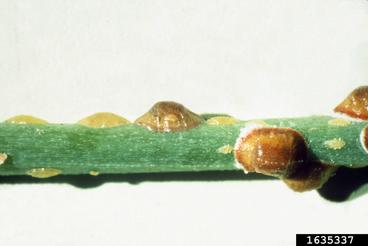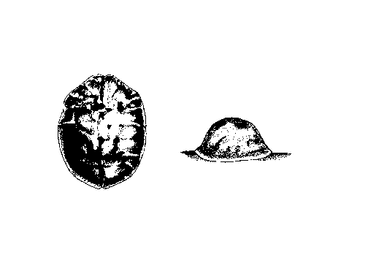SCIENTIFIC NAME: Saissetia coffeae (Walker)
CLASS: Insecta
ORDER: Hemiptera
FAMILY: Coccidae


Description
Adults
Depending on the host plant, the adult scale may vary in size. The scale varies from 4.5 millimeters on Cycas to as small as 2.0 millimeters on Asparagus fern. Relatively hemispherical, brown, smooth, and shiny, the scale may resemble a miniature army helmet. Young females may have a pattern of ridges in the form of the letter “H” on the dorsal surface.
Eggs
The oblong, pinkish-beige eggs are about 0.7 millimeter long and are protected by the mother’s body in a mass of hundreds.
Crawlers
The flat, pinkish-beige crawler is about 1.0 millimeter long with two red eye spots. The antennae and legs are short and spindly. There are two setae protruding from the rear.
Nymphs
Nymphs are semitransparent, light yellow or pink, and flat (young) to humped (older). They are so closely attached to the host plant that the legs and antennae are concealed. Two pale lines start at the margin on each side and fade in intensity toward the middle. Nymphs and young adults may exhibit the characteristic “H” pattern of the black scale group.
Biology
Host Plants
The hemispherical scale insect has a wide range of hosts including bamboo, camellia, chrysanthemum, crape myrtle, croton, ferns, figs, gardenia, honeysuckle, lily, orchids, and yamia.
Damage
The secretion of honeydew and subsequent formation of sooty mold detracts from the beauty and commercial value of the plant. Feeding causes the plant to become stunted and lose its leaves.
Life Cycle
The hemispherical scale insect is a tropical insect that has become a common greenhouse pest. In warmer temperate areas, the scale can live outside. Unlike many other scales, the hemispherical scale secretes little wax. However, the scales do produce much honeydew which allows sooty mold to grow. Males are unknown and reproduction is by parthenogenesis. Each female may deposit up to 1000 eggs. After laying the eggs, the female dies and her body shrinks to form a cup or helmet over the eggs. Development for the egg stage and the three nymphal instars requires at least 40 days and may take as long as 105 days. There may be several generations each year in the greenhouse, with all stages being present at an one time. The nymphs do not move much once they have begun to feed. The hemispherical scale insect has a low rate of parasitism indoors, and it often becomes a serious pest.
Management Strategies
Biological Control
The most important parasite of hemispherical scale in the United States is Metaphycus helvolus Compere.
Pesticides
Hemispherical scale insects are relatively difficult to control because the eggs and young nymphs are protected by the body of the mother. For specific chemical control recommendations, consult the Extension Service.